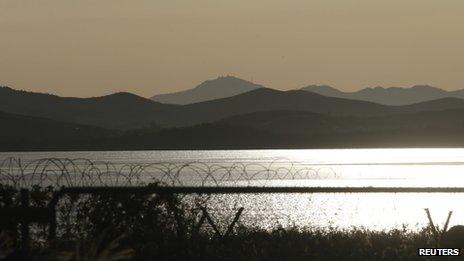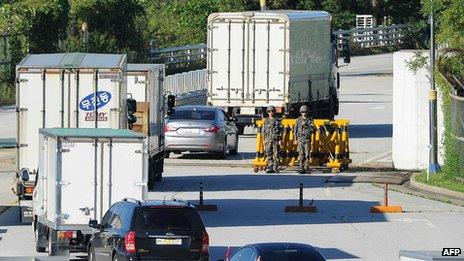South Korea shoots dead a man trying to swim to North
- Published

It is rare for anyone to attempt to cross the border between the two Koreas
South Korean troops have shot dead a man trying to swim across a border river into the North, officials say.
Soldiers opened fire after the man jumped into the Imjin river and ignored repeated warnings to stop.
The North and South remain technically at war after the 1950-53 conflict ended in an armistice and not a peace treaty.
There are thousands of North Korean defectors living in South Korea, but few attempt to make the journey the other way.
Instances of people trying to cross the heavily-militarised border in broad daylight are extremely rare.
The incident comes as South Korean workers returned to the Kaesong industrial park in North Korea, five months after work was halted amid high political tension.
The man was spotted by guards near the western border in Paju, north of Seoul, at around 14:20 local time (05:50 GMT).
Soldiers fired off warning shots and told him to return to the South. When he disobeyed the order and jumped into the river, he was shot dead by an army corporal, military officials told Yonhap news agency.
Defence ministry officials told the Associated Press that the man was carrying a South Korean passport which identified him as Nam Young-ho. He had been deported from Japan in June, the agency reported.
The BBC's correspondent in Seoul, Lucy Williamson, says the incident occurred close to the the Imjingak Memorial Park, external - a key tourist site along the demilitarised zone between the North and the South.
Months of negotiation
The shooting comes amid a thawing of ties between the North and the South as more than 800 South Koreans poured into the jointly-run Kaesong industrial complex.
The zone, just inside North Korea, is home to 123 South Korean factories that employ more than 50,000 North Koreans.
It is the last functioning inter-Korean joint project and a key source of revenue for Pyongyang.
But the North withdrew all of its workers in April, as ties between the two Koreas deteriorated in the wake of Pyongyang's 12 February nuclear test.
Reopening the complex has taken months of negotiation.

South Koreans have to pass through border checkpoints to reach the Kaesong industrial complex in the North
The restart is being described as a trial but more than half of the South Korean companies had asked North Korean employees to report for work, officials said.
Negotiations on resuming operations at the complex faltered for weeks on South Korea's insistence that safeguards must be in place to prevent any future unilateral shut-down of the site by North Korea.
The two nations are divided by the heavily-fortified demilitarised zone, agreed at the end of the Korean War.
Last Friday it emerged that a South Korean man who was abducted by North Korea 41 years ago managed to escape the North and return home.
Jeon Wook-pyo, now 68, was among 25 crewmen aboard two fishing boats captured by North Korea in the Yellow Sea in 1972. He is said to have made his way to the South via an undisclosed third country.
According to South Korea, about 500 of its citizens - most of them fishermen - are being held by North Korea.
After the North Korean famine of the 1990s, the number of people defecting from North Korea increased sharply.
Escaping North Korea is extremely difficult as all its borders are heavily patrolled. The strategy normally used is to cross the northern border into China and flee into a third country.
If China apprehends a defector, they are sent back to the North where they could face years of harsh punishment in labour camps.
Nevertheless, there are more than 24,000 North Korean defectors living in the South and in Japan as well.